Grass growth for the past seven days is around 14% ahead of the 10-year average at 57kg DM/ha/day.
However, this week last year we had done better again at 67kg DM/ha daily. We also had some farmers washed off their land with rain and others enjoying an Indian summer in the same week.
This year, the story is one of moisture, a lot of rain fell last week, particularly in the midlands and west.
Grazing fortunes now are hinging on soil’s ability to drain. Many have been forced to house cattle, as Daniel McPartlin highlights on page 12.
Unfortunately there is no significant let-up in rainfall forecast. While the volumes to come are not overly big, very saturated land may not get the three/four consecutive dry days it needs to dry out any time soon. That said, the forecasters have gotten it wrong a number of times this summer so far.
The silver lining
The silver lining is that there is heat there and intermittent bursts of sunlight which are helping to keep growth rates high.
Is land ungrazeable, or are you just in summer mode?
The temptation might be there to avoid wet areas of the farm now and graze hard on dry areas – at current growth rates we can potentially get back into a field in 18 days.
However, we ideally want to build a cover across the whole farm at this point and these dry fields will likely become very important to us as the year winds on and early in 2018.
The big question
Is land ungrazeable, or are you just in summer mode?
Think back to March and April this year when grazing was very much a smash-and-grab exercise.
The advice then was to move cattle every day.
Source some reels and split fields into small blocks. In a 1ha field with a cover of 10cm, split in four and spend a day in each portion.
There will be a small degree of poaching, but provided that depressions in the soil aren’t deeper than your baby finger, these will recover quickly, especially given that growth is still good.
Remember that the clock is ticking on fertiliser spreading. There will be a worthwhile response to fertiliser at current growth rates and any grass in the bank now will help greatly in the back end. Spread straight nitrogen and be aware of the weather forecast.
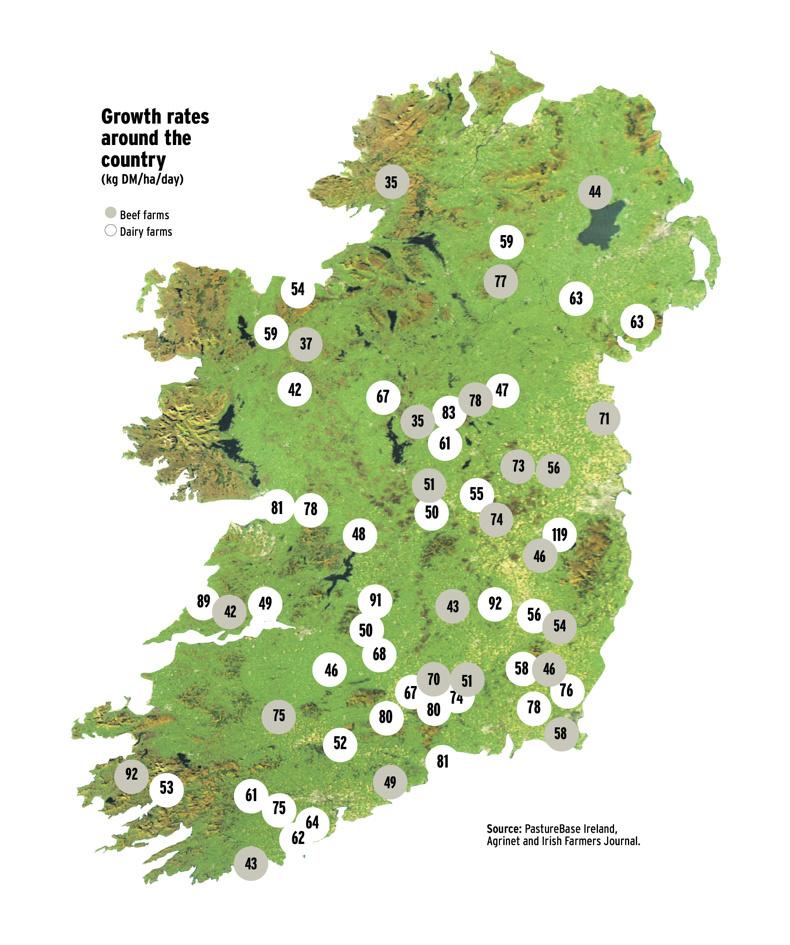
Derrypatrick Herd
System suckler to beef
Soil type mixed
Avg farm cover (kg DM/ha) 890
Grass demand (kg DM/ha/day) 41
Growth (kg DM/ha/day) 56
Last week, we recorded the highest grass growth (90kg DM/ha) on farm since the beginning of June. This burst of growth has helped to increase farm grass supply. However, growth is significantly back this week, though rates are still high for early September. The downward trend will likely continue as autumn moves in. An additional challenge for us is to graze clover trial paddocks to aid establishment while trying to build grass supply and extend the grazing rotation. We currently have 23 days of grass and are following grazing with one bag of CAN/acre.
Faecal sampling has been carried out throughout the summer to determine worm burden in calves. Until now, there has been no issue with stomach or lung worm. The recent sample revealed a faecal egg count of 175 eggs per gram (epg). As this is close to the threshold for treatment of 200epg and with current weather conditions favourable for worm infestations, calves were treated this week with a Levamisole-based product.
Co Cork
System suckler/calf to bull beef
Soil type relatively dry
Avg farm cover (kg DM/ha) 822
Grass demand (kg DM/ha/day) 34
Growth (kg DM/ha/day) 43
I finished off the last of my second cut last week after a delay. I gathered 112 bales of reasonably good-quality silage and now have over 500 bales of silage made from my 24ha farm.
I will test my silage in the next few weeks and make a call then on ration requirements for weanlings over the winter. I feed no meal to cows and my bulls will be built up to ad-lib feeding for finishing under 16 months. I may keep more of my dairy-bred calves than I previously planned for. I am finding this farm can grow significantly higher quantities of grass than I previously believed possible.
I am now getting my autumn rotation plan in place for closing up. I have spread the last round of fertiliser and will begin to close up from early October.
Being part-time, I like to have the whole farm closed by 1 November as I find it easier to work stock in the sheds once the clocks go back.
Co Wexford
System suckler to steer beef
Soil type heavy clay
Avg farm cover (kg DM/ha) 1,061
Grass demand (kg DM/ha/day) 51
Growth (kg DM/ha/day) 58
There is a good supply of grass currently on the farm. We are looking to build covers as growth starts to slow down heading into the autumn. Thankfully, we did not get as much rain as other parts of the country in recent weeks and ground conditions remain good. As a result, rate of grass utilisation remains high. The entire farm got around 20 units of nitrogen this week and there is a bit of watery slurry left which will be spread on a few paddocks low in P and K. I hope to scan in the next week or so to assess how the breeding went.
I have started meal feeding nine of my heaviest steers and I hope to have them finished before housing. I slaughtered a few heifers two weeks ago and the remainder will be slaughtered in the coming weeks.
The dairy-bred calves are currently on after-grass and 1kg of meal and I am very happy with how they are doing. I will start to wean the strongest of my suckler calves over the next few weeks.
Co Donegal
System suckler to weanling
Soil type heavy
Avg farm cover (kg DM/ha) 308
Grass demand (kg DM/ha/day) 27
Growth (kg DM/ha/day) 35
Grass was tight and ground was difficult for a while, but thankfully we have 36 acres of silage ground around the main yard coming back into play and conditions have improved. I hope to get slurry on this at the weekend and we will blanket-spread the whole farm with a bag of 18-6-12/acre before the deadline.
The cattle are all around the main yard at present as we’re in the middle of our herd test. While cows are in on Thursday we’ll scan too. I expect five or six empties and we’ll wean these, feed up for a month and move them on. I’ll hopefully be able to take in in-calf heifers to replace them, depending on cash. We are planning on keeping a number of bulls over the winter for finishing next summer. We have begun to wean and are happy with how they’re weighing. There is one December-born calf at 400kg.
We will probably dose the cows with Levifas Diamond on Thursday and wait to see what the vet recommends for the calves.
Read More
Great growth rates in high humidity
Grass growth for the past seven days is around 14% ahead of the 10-year average at 57kg DM/ha/day.
However, this week last year we had done better again at 67kg DM/ha daily. We also had some farmers washed off their land with rain and others enjoying an Indian summer in the same week.
This year, the story is one of moisture, a lot of rain fell last week, particularly in the midlands and west.
Grazing fortunes now are hinging on soil’s ability to drain. Many have been forced to house cattle, as Daniel McPartlin highlights on page 12.
Unfortunately there is no significant let-up in rainfall forecast. While the volumes to come are not overly big, very saturated land may not get the three/four consecutive dry days it needs to dry out any time soon. That said, the forecasters have gotten it wrong a number of times this summer so far.
The silver lining
The silver lining is that there is heat there and intermittent bursts of sunlight which are helping to keep growth rates high.
Is land ungrazeable, or are you just in summer mode?
The temptation might be there to avoid wet areas of the farm now and graze hard on dry areas – at current growth rates we can potentially get back into a field in 18 days.
However, we ideally want to build a cover across the whole farm at this point and these dry fields will likely become very important to us as the year winds on and early in 2018.
The big question
Is land ungrazeable, or are you just in summer mode?
Think back to March and April this year when grazing was very much a smash-and-grab exercise.
The advice then was to move cattle every day.
Source some reels and split fields into small blocks. In a 1ha field with a cover of 10cm, split in four and spend a day in each portion.
There will be a small degree of poaching, but provided that depressions in the soil aren’t deeper than your baby finger, these will recover quickly, especially given that growth is still good.
Remember that the clock is ticking on fertiliser spreading. There will be a worthwhile response to fertiliser at current growth rates and any grass in the bank now will help greatly in the back end. Spread straight nitrogen and be aware of the weather forecast.

Derrypatrick Herd
System suckler to beef
Soil type mixed
Avg farm cover (kg DM/ha) 890
Grass demand (kg DM/ha/day) 41
Growth (kg DM/ha/day) 56
Last week, we recorded the highest grass growth (90kg DM/ha) on farm since the beginning of June. This burst of growth has helped to increase farm grass supply. However, growth is significantly back this week, though rates are still high for early September. The downward trend will likely continue as autumn moves in. An additional challenge for us is to graze clover trial paddocks to aid establishment while trying to build grass supply and extend the grazing rotation. We currently have 23 days of grass and are following grazing with one bag of CAN/acre.
Faecal sampling has been carried out throughout the summer to determine worm burden in calves. Until now, there has been no issue with stomach or lung worm. The recent sample revealed a faecal egg count of 175 eggs per gram (epg). As this is close to the threshold for treatment of 200epg and with current weather conditions favourable for worm infestations, calves were treated this week with a Levamisole-based product.
Co Cork
System suckler/calf to bull beef
Soil type relatively dry
Avg farm cover (kg DM/ha) 822
Grass demand (kg DM/ha/day) 34
Growth (kg DM/ha/day) 43
I finished off the last of my second cut last week after a delay. I gathered 112 bales of reasonably good-quality silage and now have over 500 bales of silage made from my 24ha farm.
I will test my silage in the next few weeks and make a call then on ration requirements for weanlings over the winter. I feed no meal to cows and my bulls will be built up to ad-lib feeding for finishing under 16 months. I may keep more of my dairy-bred calves than I previously planned for. I am finding this farm can grow significantly higher quantities of grass than I previously believed possible.
I am now getting my autumn rotation plan in place for closing up. I have spread the last round of fertiliser and will begin to close up from early October.
Being part-time, I like to have the whole farm closed by 1 November as I find it easier to work stock in the sheds once the clocks go back.
Co Wexford
System suckler to steer beef
Soil type heavy clay
Avg farm cover (kg DM/ha) 1,061
Grass demand (kg DM/ha/day) 51
Growth (kg DM/ha/day) 58
There is a good supply of grass currently on the farm. We are looking to build covers as growth starts to slow down heading into the autumn. Thankfully, we did not get as much rain as other parts of the country in recent weeks and ground conditions remain good. As a result, rate of grass utilisation remains high. The entire farm got around 20 units of nitrogen this week and there is a bit of watery slurry left which will be spread on a few paddocks low in P and K. I hope to scan in the next week or so to assess how the breeding went.
I have started meal feeding nine of my heaviest steers and I hope to have them finished before housing. I slaughtered a few heifers two weeks ago and the remainder will be slaughtered in the coming weeks.
The dairy-bred calves are currently on after-grass and 1kg of meal and I am very happy with how they are doing. I will start to wean the strongest of my suckler calves over the next few weeks.
Co Donegal
System suckler to weanling
Soil type heavy
Avg farm cover (kg DM/ha) 308
Grass demand (kg DM/ha/day) 27
Growth (kg DM/ha/day) 35
Grass was tight and ground was difficult for a while, but thankfully we have 36 acres of silage ground around the main yard coming back into play and conditions have improved. I hope to get slurry on this at the weekend and we will blanket-spread the whole farm with a bag of 18-6-12/acre before the deadline.
The cattle are all around the main yard at present as we’re in the middle of our herd test. While cows are in on Thursday we’ll scan too. I expect five or six empties and we’ll wean these, feed up for a month and move them on. I’ll hopefully be able to take in in-calf heifers to replace them, depending on cash. We are planning on keeping a number of bulls over the winter for finishing next summer. We have begun to wean and are happy with how they’re weighing. There is one December-born calf at 400kg.
We will probably dose the cows with Levifas Diamond on Thursday and wait to see what the vet recommends for the calves.
Read More
Great growth rates in high humidity








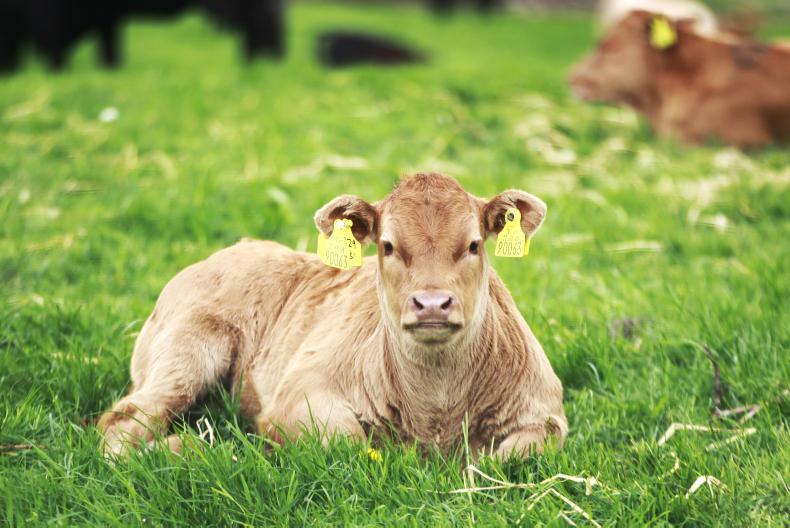
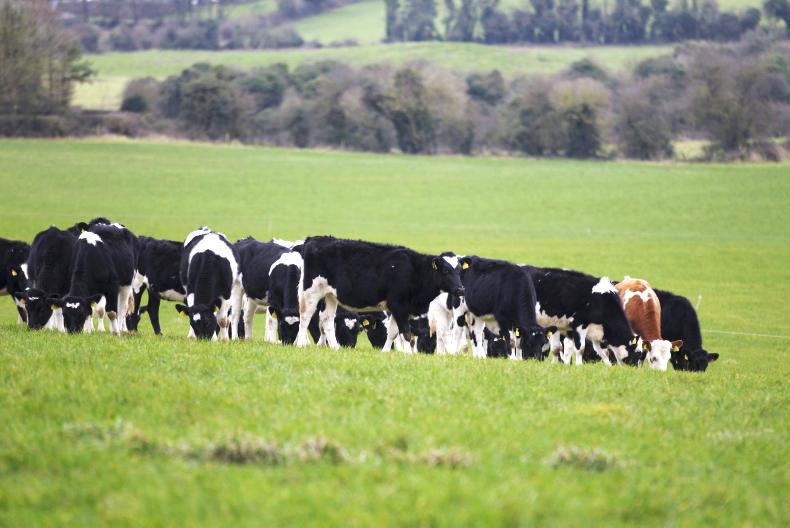

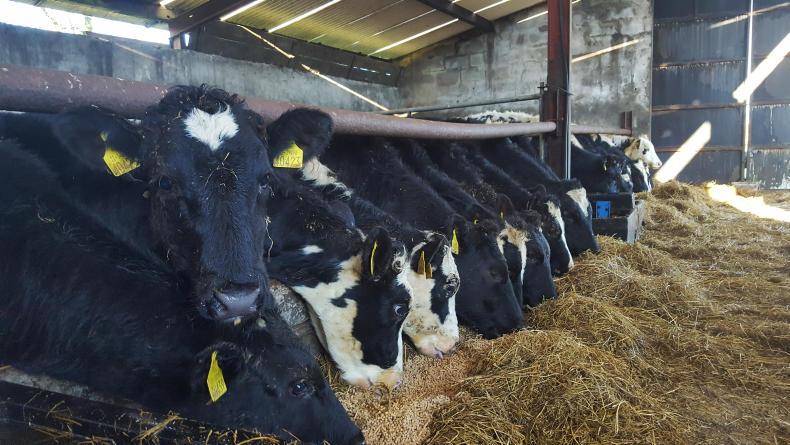
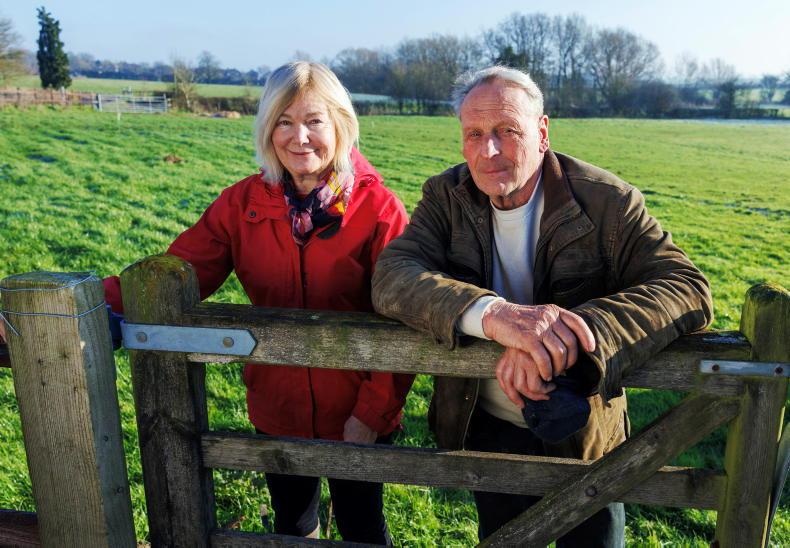

SHARING OPTIONS